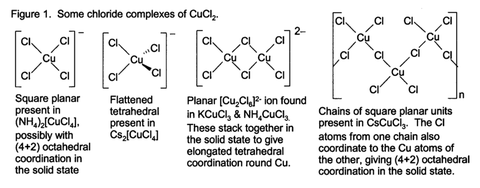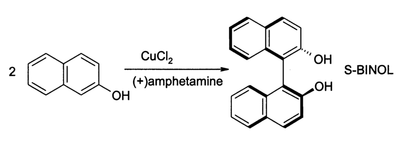- Copper(II) chloride
-
Copper(II) chloride 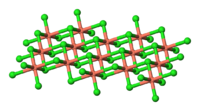
Anhydrous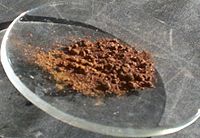
Anhydrous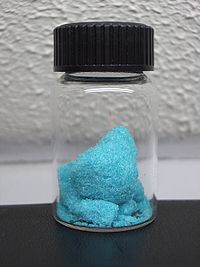
DihydrateCopper(II) chloride
Copper dichlorideOther namesCupric chlorideIdentifiers CAS number 7447-39-4  ,
,
10125-13-0 (dihydrate)PubChem 169664 ChemSpider 148374 
UNII P484053J2Y 
ChEBI CHEBI:49553 
ChEMBL CHEMBL1200553 
RTECS number GL7000000 Jmol-3D images Image 1
Image 2- Cl[Cu]Cl
[Cu+2].[Cl-].[Cl-]
Properties Molecular formula CuCl2 Molar mass 134.45 g/mol (anhydrous)
170.48 g/mol (dihydrate)Appearance yellow-brown solid (anhydrous)
blue-green solid (dihydrate)Density 3.386 g/cm3 (anhydrous)
2.51 g/cm3 (dihydrate)Melting point 498 °C (anhydrous)
100 °C (dehydration of dihydrate)Boiling point 993 °C (anhydrous, decomp)
Solubility in water 706 g/L (0 °C)
757 g/L (25 °C)Structure Crystal structure distorted CdI2 structure Coordination
geometryOctahedral Hazards MSDS Fischer Scientific EU classification Not listed NFPA 704 Flash point Non-flammable Related compounds Other anions Copper(II) fluoride
Copper(II) bromideOther cations Copper(I) chloride
Silver chloride
Gold(III) chloride chloride (verify) (what is:
chloride (verify) (what is:  /
/ ?)
?)
Except where noted otherwise, data are given for materials in their standard state (at 25 °C, 100 kPa)Infobox references Copper(II) chloride is the chemical compound with the formula CuCl2. This is a light brown solid, which slowly absorbs moisture to form a blue-green dihydrate. The copper(II) chlorides are some of the most common copper(II) compounds, after copper sulfate.
Contents
Structure
Anhydrous CuCl2 adopts a distorted cadmium iodide structure. In this motif, the copper centers are octahedral. Most copper(II) compounds exhibit distortions from idealized octahedral geometry due to the Jahn-Teller effect, which in this case describes the localization of one d-electron into a molecular orbital that is strongly antibonding with respect to a pair of chloride ligands. In CuCl2·2H2O, the copper again adopts a highly distorted octahedral geometry, the Cu(II) centers being surrounded by two water ligands and four chloride ligands, which bridge asymmetrically to other Cu centers.[1]
Copper(II) chloride is paramagnetic. Of historical interest, CuCl2·2H2O was used in the first electron paramagnetic resonance measurements by Yevgeny Zavoisky in 1944.[2][3]
Properties and reactions
Aqueous solutions of "copper(II) chloride". Greenish when high on [Cl–], more blue when lower on [Cl–].
Aqueous solution prepared from copper(II) chloride contain a range of copper(II) complexes depending on concentration, temperature,and the presence of additional chloride ions. These species include blue color of [Cu(H2O)6]2+ and yellow or red color of the halide complexes of the formula [CuCl2+x]x−.[4]
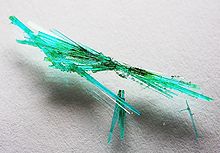 Copper(II) chloride dihydrate crystal
Copper(II) chloride dihydrate crystal
It decomposes to CuCl and Cl2 at 1000 °C:
- 2 CuCl2 → 2 CuCl + Cl2
It reacts with HCl or other chloride sources to form complex ions: the red CuCl3−, and the yellow CuCl42−.[5]
Some of these complexes can be crystallized from aqueous solution, and they adopt a wide variety of structural types (Fig. 1).
Copper(II) hydroxide precipitates upon treating copper(II) chloride solutions with base:
- CuCl2 + 2 NaOH → Cu(OH)2 + 2 NaCl
Copper(II) chloride also forms a variety of coordination complexes with ligands such as pyridine and triphenylphosphine oxide:
- CuCl2 + 2 C5H5N → [CuCl2(C5H5N)2] (tetragonal)
- CuCl2 + 2 (C6H5)3P=O → [CuCl2((C6H5)3P=O)2] (tetrahedral)
However "soft" ligands such as phosphines (e.g., triphenylphosphine), iodide, and cyanide as well as some tertiary amines cause reduction to give copper(I) complexes. To convert copper(II) chloride to copper(I) derivatives it is generally more convenient to reduce an aqueous solution with sulfur dioxide as the reductant:
- 2 CuCl2 + SO2 + 2 H2O → 2 CuCl + 2 HCl + H2SO4
Hydrolysis give the copper oxychloride, Cu2Cl(OH)3, a popular fungicide.
Preparation
Copper(II) chloride is prepared commercially by the action of chlorination of copper:
- Cu + Cl2 + 2 H2O → CuCl2(H2O)2
It can also be generated by treatment of the hydroxide, oxide, or copper(II) carbonate with hydrochloric acid. Electrolysis of aqueous sodium chloride with copper electrodes produces (among other things) a blue-green foam that can be collected and converted to the hydrate.
Anhydrous CuCl2 may be prepared directly by union of the elements, copper and chlorine.
CuCl2 may be purified by crystallization from hot dilute hydrochloric acid, by cooling in a CaCl2-ice bath.[6][7]
Natural occurrence
Copper(II) chloride occurs naturally as the very rare mineral tolbachite and the dihydrate eriochalcite. Both are found near fumaroles. More common are mixed oxyhydroxide-chlorides like atacamite Cu2(OH)3Cl, arising among Cu ore beds oxidation zones in arid climate (also known from some altered slags).
Uses
Co-catalyst in Wacker process
A major industrial application for copper(II) chloride is as a co-catalyst with palladium(II) chloride in the Wacker process. In this process, ethene (ethylene) is converted to ethanal (acetaldehyde) using water and air. During the reaction, PdCl2 is reduced to Pd, and the CuCl2 serves to re-oxidize this back to PdCl2. Air can then oxidize the resultant CuCl back to CuCl2, completing the cycle.
- C2H4 + PdCl2 + H2O → CH3CHO + Pd + 2 HCl
- Pd + 2 CuCl2 → 2 CuCl + PdCl2
- 4 CuCl + 4 HCl + O2 → 4 CuCl2 + 2 H2O
The overall process is:
- 2 C2H4 + O2 → 2 CH3CHO
Chlorinations
Copper(II) chloride catalyzes the chlorination in the production of vinyl chloride and dichloroethane.[8]
Other organic synthetic applications
Copper(II) chloride has a variety of specialized applications in the synthesis of organic compounds.[6] It effects chlorination of aromatic hydrocarbons- this is often performed in the presence of aluminium oxide. It is able to chlorinate the alpha position of carbonyl compounds:[9]
This reaction is performed in a polar solvent such as dimethylformamide (DMF), often in the presence of lithium chloride, which accelerates the reaction.
CuCl2, in the presence of oxygen, can also oxidize phenols. The major product can be directed to give either a quinone or a coupled product from oxidative dimerization. The latter process provides a high-yield route to 1,1-binaphthol:[10]
Such compounds are intermediates in the synthesis of BINAP and its derivatives
Copper(II) chloride dihydrate promotes the hydrolysis of acetonides, i.e., for deprotection to regenerate diols[11] or aminoalcohols, as in this example (where TBDPS = tert-butyldiphenylsilyl):[12]
CuCl2 also catalyses the free radical addition of sulfonyl chlorides to alkenes; the alpha-chlorosulfone may then undergo elimination with base to give a vinyl sulfone product.[citation needed]
Niche uses
Copper(II) chloride is also used in pyrotechnics as a blue/green coloring agent. In a flame test, copper chlorides, like all copper compounds, emit green-blue.
Safety
It is toxic and only concentrations below 5 ppm are allowed in drinking water by the US Environmental Protection Agency.
References
- ^ Wells, A.F. (1984) Structural Inorganic Chemistry, Oxford: Clarendon Press. ISBN 0-19-855370-6.
- ^ Peter Baláž (2008). Mechanochemistry in Nanoscience and Minerals Engineering. Springer. p. 167. ISBN 3540748547. http://books.google.com/?id=FldqbSffUMgC&pg=PA167.
- ^ Marina Brustolon (2009). Electron paramagnetic resonance: a practitioner's toolkit. John Wiley and Sons. p. 3. ISBN 0470258829. http://books.google.com/?id=l3F9yUSk-rgC&pg=PA3.
- ^ Greenwood, N. N. and Earnshaw, A. (1997). Chemistry of the Elements (2nd Edn.), Oxford:Butterworth-Heinemann. ISBN 0-7506-3365-4.
- ^ Naida S. Gill et al. (1967). Tetrahalo Complexes of Dipositive Metals in the First Transition Series. "Inorganic Syntheses". Inorg. Synth.. Inorganic Syntheses 9: 136–142. doi:10.1002/9780470132401.ch37. ISBN 9780470132401.
- ^ a b S. H. Bertz, E. H. Fairchild, in Handbook of Reagents for Organic Synthesis, Volume 1: Reagents, Auxiliaries and Catalysts for C-C Bond Formation, (R. M. Coates, S. E. Denmark, eds.), pp. 220-3, Wiley, New York, 1999.
- ^ W. L. F. Armarego, Christina Li Lin Chai (2009-05-22) (Google Books excerpt). Purification of Laboratory Chemicals (6th ed.). Butterworth-Heinemann. pp. 461. ISBN 1856175677. http://books.google.com/?id=PTXyS7Yj6zUC&pg=PA461.
- ^ H.Wayne Richardson, "Copper Compounds" in Ullmann's Encyclopedia of Industrial Chemistry, 2005, Wiley-VCH, Weinheim, doi:10.1002/14356007.a07_567
- ^ C. E. Castro, E. J. Gaughan, D. C. Owsley (1965). "Cupric Halide Halogenations". Journal of Organic Chemistry 30 (2): 587. doi:10.1021/jo01013a069.
- ^ J. Brussee, J. L. G. Groenendijk, J. M. Koppele, A. C. A. Jansen (1985). "On the mechanism of the formation of s(−)-(1, 1'-binaphthalene)-2,2'-diol via copper(II)amine complexes". Tetrahedron 41 (16): 3313. doi:10.1016/S0040-4020(01)96682-7.
- ^ Chandrasekhar, M.; Kusum L. Chandra, and Vinod K. Singh (2003). "Total Synthesis of (+)-Boronolide, (+)-Deacetylboronolide, and (+)-Dideacetylboronolide". Journal of Organic Chemistry 68 (10): 4039–4045. doi:10.1021/jo0269058. PMID 12737588.
- ^ Krishna, Palakodety Radha; G. Dayaker (2007). "A stereoselective total synthesis of (-)-andrachcinidine via an olefin cross-metathesis protocol". Tetrahedron Letters (Elsevier) 48 (41): 7279–7282. doi:10.1016/j.tetlet.2007.08.053.
Further reading
- Greenwood, Norman N.; Earnshaw, Alan (1997). Chemistry of the Elements (2nd ed.). Oxford: Butterworth-Heinemann. ISBN 0080379419.
- Lide, David R. (1990). CRC handbook of chemistry and physics: a ready-reference book of chemical and physical data. Boca Raton: CRC Press. ISBN 0-8493-0471-7.
- The Merck Index, 7th edition, Merck & Co, Rahway, New Jersey, USA, 1960.
- D. Nicholls, Complexes and First-Row Transition Elements, Macmillan Press, London, 1973.
- A. F. Wells, 'Structural Inorganic Chemistry, 5th ed., Oxford University Press, Oxford, UK, 1984.
- J. March, Advanced Organic Chemistry, 4th ed., p. 723, Wiley, New York, 1992.
- Fieser & Fieser Reagents for Organic Synthesis Volume 5, p158, Wiley, New York, 1975.
- D. W. Smith (1976). "Chlorocuprates(II)". Coordination Chemistry Reviews 21 (2–3): 93–158. doi:10.1016/S0010-8545(00)80445-2.
External links
- Copper (II) Chloride - Description and Pictures
- National Pollutant Inventory - Copper and compounds fact sheet[dead link]
Copper compounds Categories:- Copper compounds
- Chlorides
- Metal halides
- Semiconductor materials
- Coordination compounds
- Pyrotechnic colorants
- Cl[Cu]Cl
Wikimedia Foundation. 2010.


